Have you ever visited a place that made you feel a bit on edge?
Like you half-expected something scary and spectral to brush past you or your skin suddenly crawled and you felt your hands cold and clammy and your heart skipping a beat?!
Discovering local legends and beliefs and getting to explore the places where these were born based on superstitions or even actual historic events is one of the most fascinating experiences to have when you travel. And if you travel to the Northern Italian region of the Veneto, you will have plenty of opportunities to do just that.

A land with an ancient history stretching back to at least the Bronze Age, many tribes and people cut paths through it as the centuries slowly flew away. The powerful mountains, the deep lakes, the impenetrable forests – they all left an imprint on human imagination and soon stories about dangerous forest creatures and vengeful divinities started to circulate.
Certain real-life events, on the other hand, gained the status of legends as time trickled by. And soon bloodthirsty lords became pale ghosts looking to regain their lost power while spurned lovers began haunting medieval castles and Renaissance palaces.
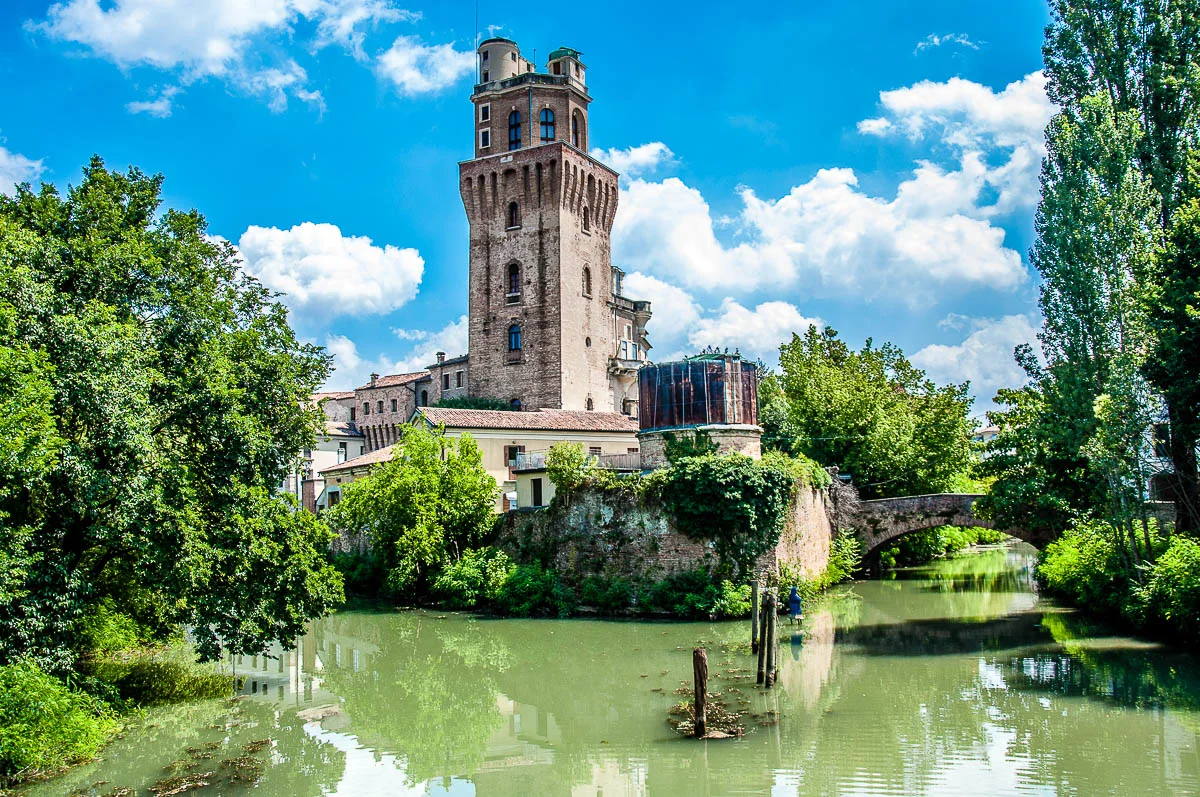
So, with Halloween just around the corner, it’s now the right time to delve into the legends and the stories of the Veneto and regale ourselves with some creepy and mysterious tales. Each one of them is tied to a particular place in this Northern Italian region that you can visit when you have the chance so as to experience its mystery first hand.
Now, sit closely, and let’s start!
10 Mysterious Places to Visit in Veneto, Italy
1. Dante’s Hill
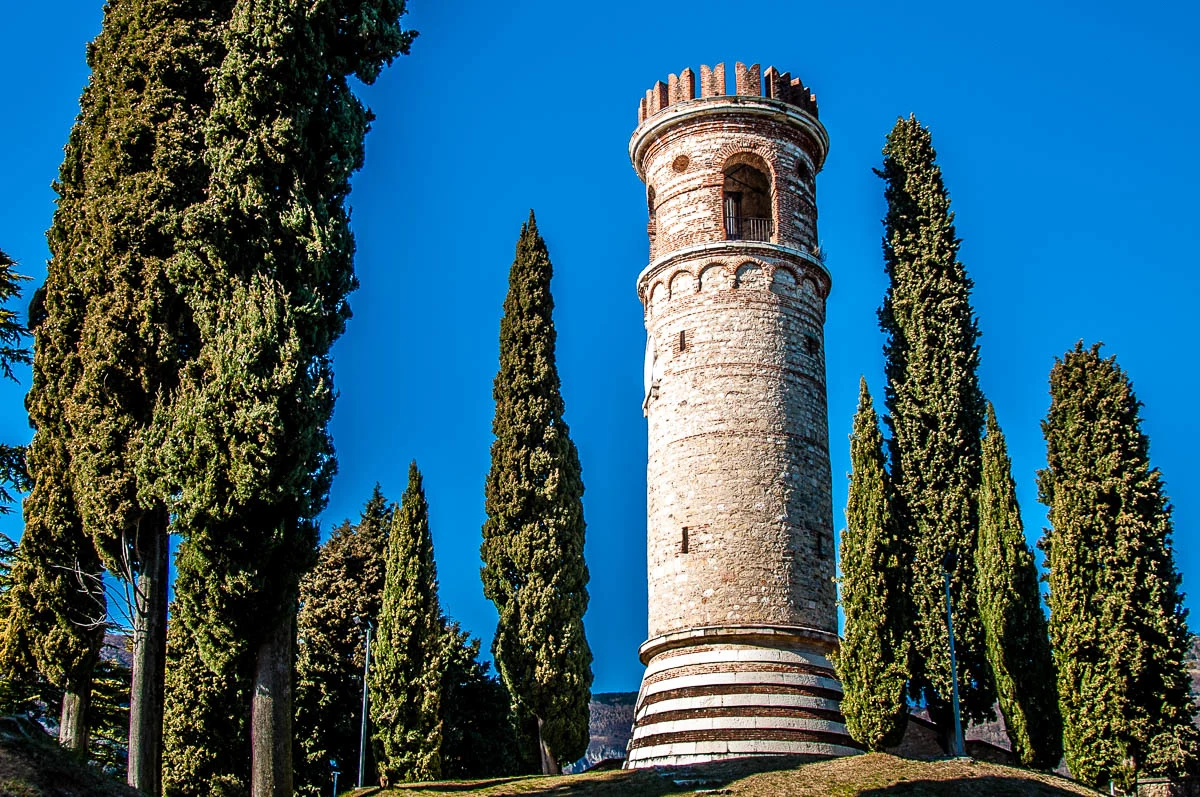
Dante’s Hill is a tiny mound in the Veneto with a big story attached to it. The legend has it that the infamous tyrant Ezzellino III da Romano haunts a secret cave inside the hill.
Ezzellino III was a medieval lord from the Da Romano dynasty. In the 13th century, he ruled over a large portion of the lands of modern-day Veneto. From Verona to Padua and from Vicenza to Treviso, he waged war against other feudal lords, grabbed land, and controlled people with an iron fist.
Excommunicated from the church, such was Ezzelino III da Romano’s infamy that he is even mentioned in Inferno – the first part of Dante’s Divine Comedy. There, Ezzelino is submerged up to his eyebrows in a river of boiling blood in a corner of the Hell reserved for those who, in life, had been cruel to their neighbours.
If you believe the local legend though, Ezzelino’s ghost is imprisoned by two devils in a cave secreted inside Dante’s Hill. There the tyrant pines for his lost power and might.
I walked to the top of Dante’s Hill on a sunny day in the early spring. The small mound is right next to the tiny town of Romano d’Ezzelino and near the city of Bassano del Grappa in the foothills of Monte Grappa in the Venetian Pre-Alps.
Called Dante’s Hill on account of also being mentioned in Dante’s Divine Comedy, the mound opens spellbinding views over the Venetian plains and hilly groups. The hill – peaceful and green in the bright sun – had a quasi-magical feeling to it. It wasn’t difficult to imagine the possibility of another realm intersecting there with what we call reality and having a cavernous grotto hiding underneath my feet where hellish tortures were being inflicted on a legendary tyrant.
More Information:
2. Villa da Porto, Montorso Vicentino

The figure of the tortured artist nowadays is quite the cliche. Yet, here is a real-life story about a tortured writer and the local belief that the writer’s soul haunts to this day a large villa in the small town of Montorso Vicentino in the lush plains of the Veneto.
Luigi da Porto was a 16th-century nobleman from the nearby city of Vicenza who retreated to the countryside to write after he had been gravely wounded in a military campaign. From the windows of his villa in Montorso Vicentino, da Porto could see two medieval hilltop castles – the Castle of Villa and the Castle of Bellaguardia.
Gazing up at them and finding inspiration in his love troubles, between 1512 and 1524 da Porto penned a novella: Historia novellamente ritrovata di due nobili amanti (in English: A Newly Found Story of Two Noble Lovers). He dedicated it to his cousin Lucina Sarvognan whom he was in love with.
The plot of da Porto’s novel was set in Verona and its leading characters were one Romeo Montecchi and his beloved Giulietta Capuletti. Da Porto outlined the young couple’s tragic love and ultimate death. In addition, he introduced the characters of Mercutio, Tybalt, Friar Laurence, and Paris.
The novella was published in Venice in 1531 – after the writer’s death – and it was so successful that it was even translated into English. In time, it inspired the famous English playwright William Shakespeare to write what is most possibly the most famous play in the world – Romeo and Juliet.
Da Porto’s name was quickly forgotten and all accolades to this day go straight to Shakespeare. So, they say that – bitter and angry for missing out on the recognition that he rightfully deserved – Luigi da Porto’s ghost haunts his former villa in Montorso Vicentino.
I went to see Villa da Porto on a bright summer day. It was hot and the small town around it was deeply asleep during Italy’s traditional riposo. The villa – enormous, with a bit of a neglected look, and under lock – had an almost tortured feel to it. Although the building had been rebuilt and expanded several times since Luigi da Porto had called it home, in my mind’s eye I could see how it could serve as the perfect backdrop for an anguished soul.
Especially with the two medieval castles still clearly visible on their lush hilltops far on Veneto’s horizon.
More Information:
3. Scoglio della Stella, Lake Garda

Scoglio della Stella (in English, Stella’s Rock) is a small outcrop bathed by the waters of Italy’s largest lake – Lago di Garda.
You will find it just off the tip of the small harbour of Punta di San Vigilio – a long promontory with a tiny medieval hamlet which has been turned into a luxury resort.
Punta di San Vigilio is renowned as the most romantic place on Lake Garda, Italy. Many people flock there in summer to enjoy a drink in the tavern around the old harbour and to take in the splendid lake views. Standing at the harbour, you see Scoglio della Stella right in front of you.
Nowadays, this rocky outcrop serves as a place of relaxation for the Lake Garda’s cormorants. They sit there grooming their feathers and digesting their lunch of freshly caught fish. At a first glance, the cormorants’ activities seem much more interesting than the pile of rocks on which they stand.
If the local legend is to be believed though, the outcrop is the lake nymph Stella herself. She was turned into stone after rebuffing the advances of the satyr Vigilius – the grandson of the god of the woods.
I first saw Scoglio della Stella on a grey December day. I stood on the edge of the stone jetty of Punta di San Vigilio’s harbour and just took the beautiful views in. My eyes kept returning to the small outcrop and the gaggle of cormorants sitting on it. I felt that there was something magical and just a bit sad about it.
It was only later that I came across the legend about how the Scoglio della Stella came to be. If you are open to magical interpretations, then when looking at the outcrop, your eyes can just about make the outline of what many aeons ago could have been the womanly body of a lake nymph.
More Information:
4. Baia delle Sirene, Lake Garda
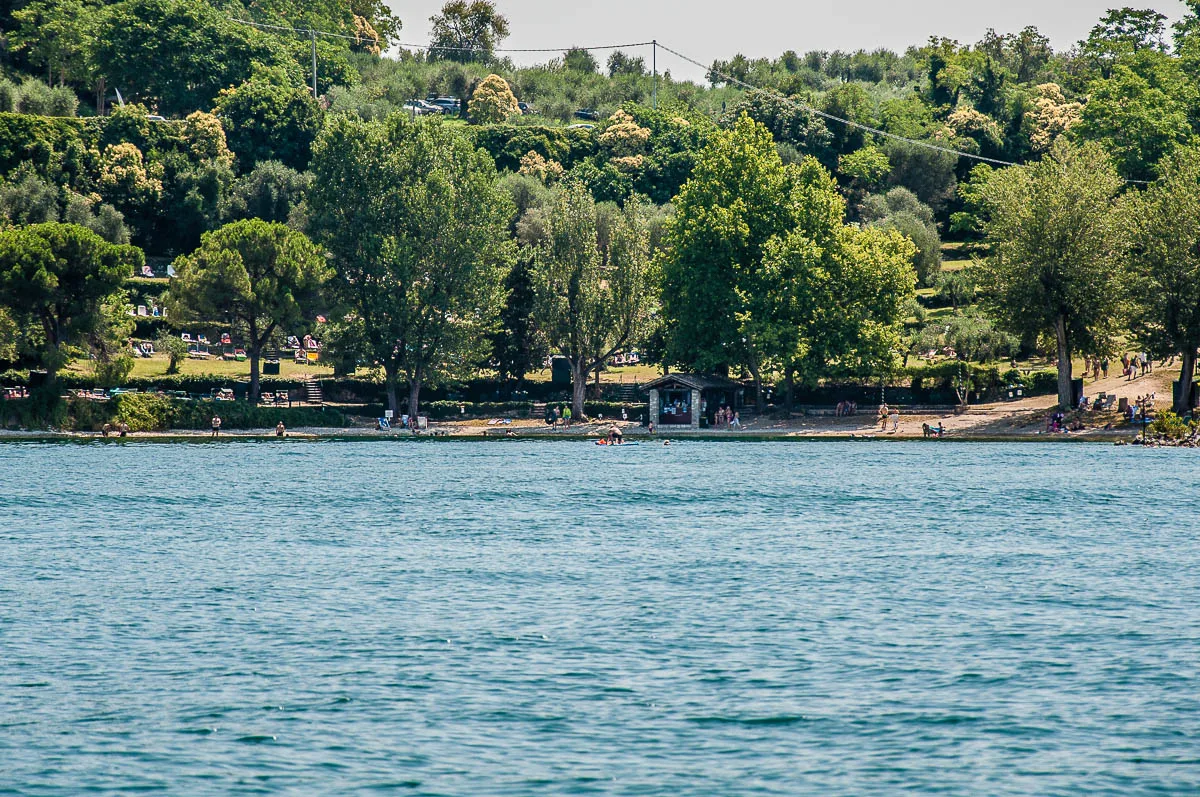
Punta di San Vigilio (see point 3 above) on Lake Garda has another corner that features in legends and myths of days of yore and today.
If you come here for a walk and to experience the renowned romantic atmosphere, then don’t miss the Baia delle Sirene (Mermaids’ Bay). It’s just around the corner from the small harbour with the Scoglio della Stella from point 3 above.
A local legend states that the lake mermaids lived in this beautiful bay. Hence its name. They possessed a magical drink – the Elixir of Love – which they gifted to the local sailors when they saw them relaxing onshore one day. This, if you believe the legend, made both the sailors and their wives very happy indeed.
There is another mysterious happening centred around the Baia delle Sirene though. Stories about a huge serpentine creature haunting Lake Garda have been circulating the lake shores for centuries. It was only in 2013 though, after a mother and a child glimpsed a 15 m long snake-like animal with the head of a whale emerge close to the Baia delle Sirene in Punta di San Vigilio, that the creature was officially recognised as a monster and given the name Bennie (from Lake Garda’s old Latin name – Lacus Benacus).
Baia delle Sirene is a truly magical place to visit on Lake Garda. It is here that you will find one of the most beautiful and well-appointed beaches on Italy’s largest lake. On a sunny day when the waters sparkle in a myriad of green and blue shades, you feel like a mermaid yourself swimming and having fun.
In winter, there is no access to the beach but you can steal a glance at Baia delle Sirene as you drive above it on the lakeside road.
More Information:
5. Borghetto sul Mincio
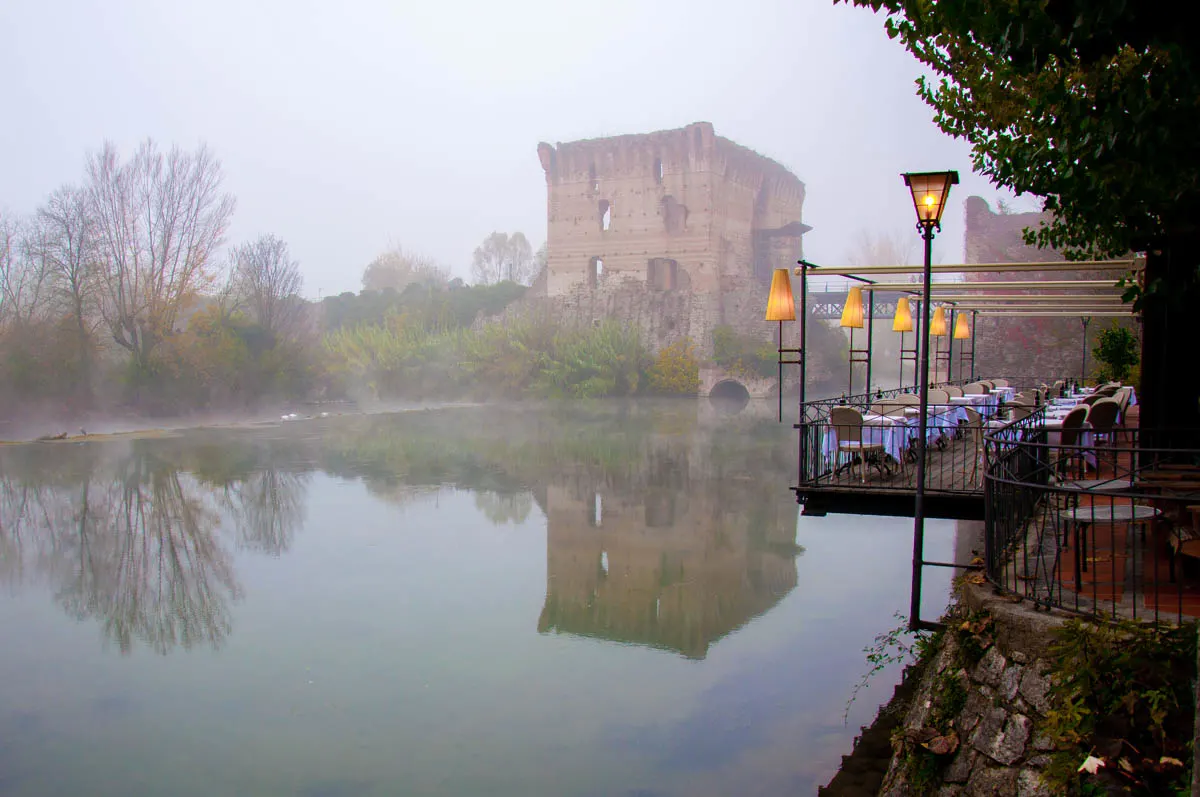
Borghetto sul Mincio is one of the most beautiful villages to see for yourself in the Veneto, Italy.
A small medieval hamlet with old mills built on top of the river Mincio, Borghetto is a sight to behold. Especially, if you take your first look at it from the nearby 14th-century Visconti bridge or the medieval castle on top of the adjacent hill.
Most of the mills in Borghetto sul Mincio nowadays have been turned into restaurants serving the renowned local speciality – tortellini nodo d’amore – love-knot tortellini. Their shape, the local legend states, was inspired by the knotted handkerchief that the river nymph Silvia gave to her beloved Marco as a sign of her undying love.
Looking at the fast-running waters of the river Mincio and the lush reeds that grow along its shores, it’s easy to imagine this being the perfect ground for nymphs and other mythical creatures.
In addition, the medieval castle that overlooks Borghetto sul Mincio is allegedly haunted by the spirit of its former lord – Andriolo da Parma. At the beginning of the 15th century, Andriolo conspired to surrender his castle to the Republic of Venice. This enraged the Lords of Padua who at the time controlled the lands around Borghetto.
Andriolo was captured and then promptly quartered. They say that since then, on full-moon nights his ghost haunts the ruins of the hilltop castle and the locals tend to stay away from it then.
I have visited Borghetto sul Mincio many times during my six years in Italy. It’s difficult to find a more beautiful little hamlet anywhere in the world. It’s a magical place that has all the ingredients for many fantastical stories and then some. Centuries-old ruined castle and bridge, a mighty river, and picture-perfect surroundings.
I never felt goosebumps there, even on the foggiest of day, yet, I surrendered to the magic of Borghetto sul Mincio the minute I laid my eyes on it for the very first time.
More Information:
6. Montagna Spaccata
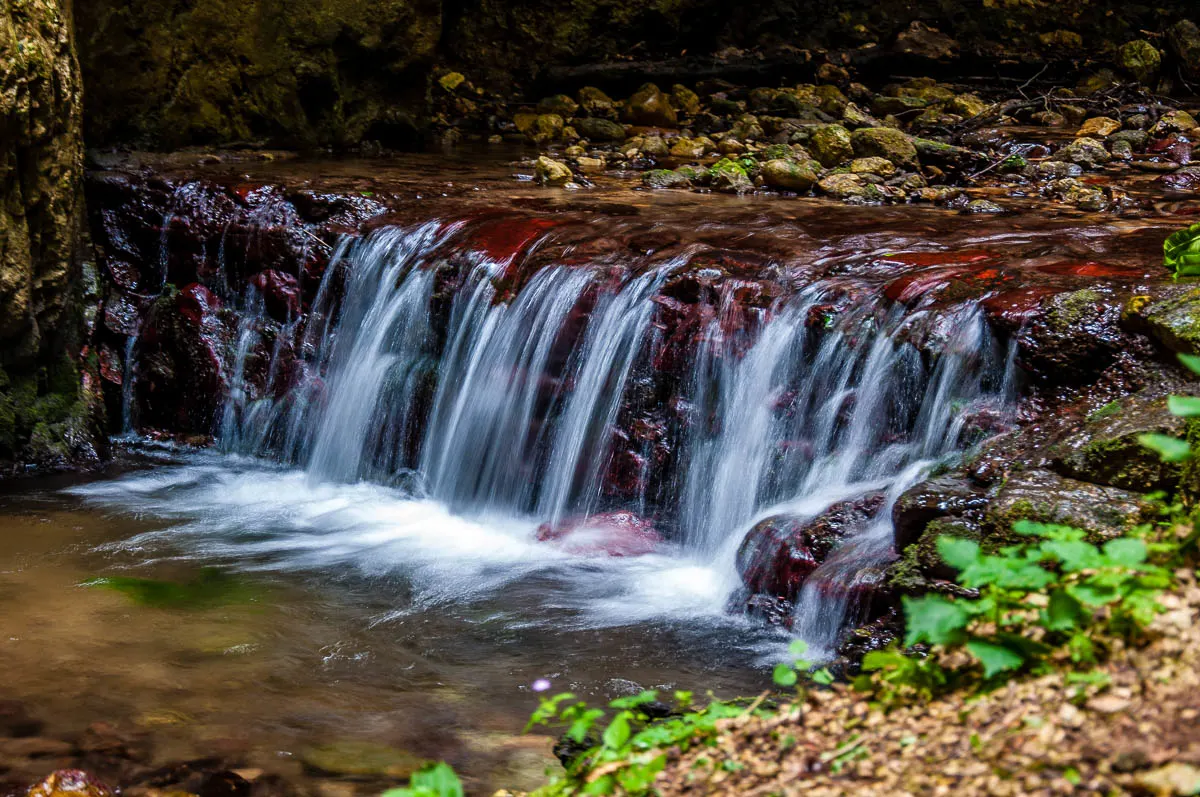
Montagna Spaccata means literally the Split Mountain in English. And what an apt name this is for this deep gorge in the Little Dolomites in the Veneto, Italy.
Imagine a path through a narrow ravine. Tall, rugged rocks stand guard on both of your sides. And then, a small river runs fast right next to you fed by weirs and waterfalls. It’s so easy to fall under the magic of this place.
It’s no wonder, really, that for many centuries the local people believed that Montagna Spaccata was one of the spots in the Veneto where the anguane came to wash their cloths.
The anguana (pl. anguane) is a beautiful mythological creature from the Veneto. At a first glance, the anguane look like exceptionally beautiful girls. They are charming, have flowing red hair, sing well, dance gracefully, and love to seduce handsome young men to then imprison them for life. Look a bit closer though, the legends say, and you will notice that the anguane have either cloven or chicken feet, often a hunched back, and in some variations – breasts so long that they can drape them over their shoulders and breastfeed their children whom they carry in a basket on their backs.
The anguane can be very sweet but don’t dare offend them or make fun of them. Their vengeance knows no bounds.
Following the short hike through Montagna Spaccata with all the water rushing, falling, and rustling all around me, I was charmed. I just had to close my eyes to imagine the beautiful anguane washing their cloths on the river’s edge.
Montagna Spaccata certainly speaks to your imagination and it’s one of the most beautiful hidden corners of the Veneto to tick off if you like nature, hiking, waterfalls, and local myths.
Be aware that to access the Montagna Spaccata’s hiking path, there is an entry charge and you will need to wear a protective helmet (provided onsite) all the way through. The opening hours and days vary in accordance with the season and weather. You can find all the details at the Montagna Spaccata’s official website (in Italian).
More Information:
7. La Torlonga, Padua
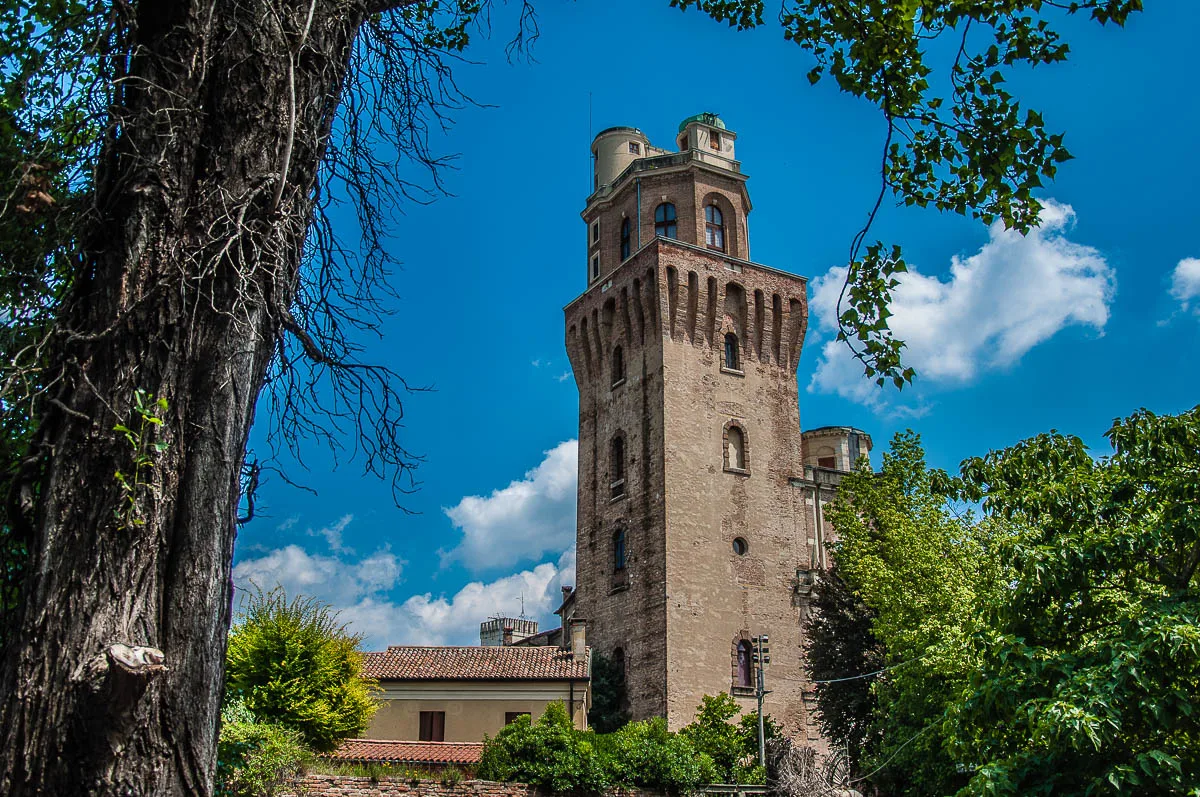
La Torlonga is an ancient tall tower in the city of Padua in the Veneto, Italy. It has kept watch over the city for more than a thousand years.
Originally erected in the 9th century at the point where the river Bacchiglione splits in two, La Torlonga was largely rebuilt in the 13th century by the infamous tyrant Ezzelino III da Romano (see point 1 above) who used it as a prison. Such was Ezzelino’s thirst for blood that, they say, over ten thousand people perished in the tower during his reign.
Among them was Sarpendone – a handsome fellow and one of Ezzelino’s most trusted knights. Selvaggia – Ezzelino’s wife – fell for Sarpendone and seduced him. When Ezzelino found out, he imprisoned the knight in La Torlonga and submitted him to a cruel sequence of tortures and humiliations which culminated in Sarpendone’s castration. Then Ezzelino abandoned him in the tower to die of his wounds.
Nowadays, after it was significantly restructured and its height increased in the 18th century, La Torlonga serves as the Museum of Padua’s Astronomical Observatory. The tower today also has a new name – La Specola (in English, The Observatory). It reflects the fact that for 250 years in its most recent history, La Torlonga was used for astronomical studies and observations.
Still, the local legend states that the tormented spirit of Sarpendone haunts to this day the tall tower that has seen Padua grow and change over the last millennium. Some even state that at night screams can often be heard coming from the former prison where so many people had died violent deaths in the past.
La Torlonga can be glimpsed from Padua’s central part but to reach it you need to walk a bit beyond the usual tourist sights. Standing tall over the river Bacchiglione, the tower looks dark and brooding. I last saw it on a hot summer day when the bright rays of the sun made me feel dizzy after a long walk through the city’s historic centre.
Looking at this building that has seen so much, I could only wistfully sigh: ‘If these walls could talk!’
The Museum of Padua’s Astronomical Observatory has limited opening hours. If you are interested in seeing it for yourself, have a look at this official link and call the numbers provided to double-check that you would be able to visit on a particular day. Otherwise, you can see La Torlonga (also known as La Specola) from the outside at any time of the day.
8. Laghetto dell’Elefante Bianco
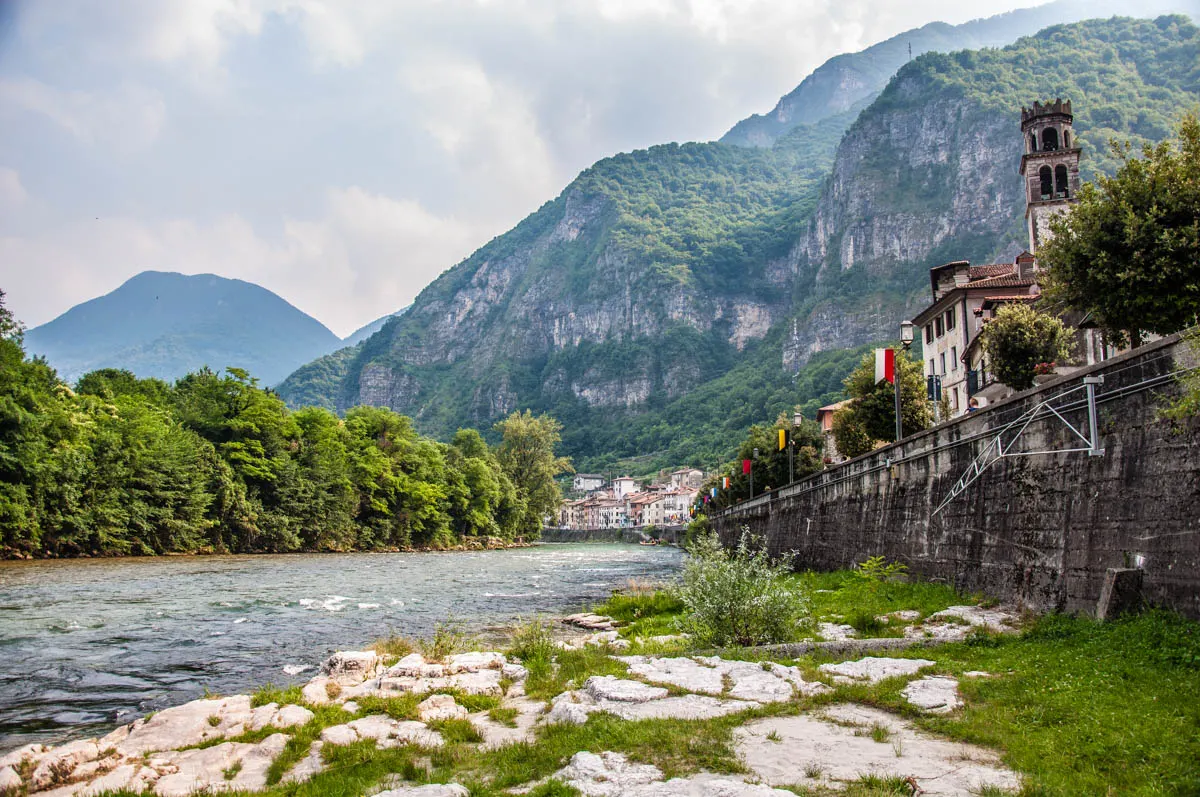
The Laghetto dell’Elefante Bianco left an indelible impression in me. Its name literally means the Small Lake of the White Elephant although locally it is also known as Laghetto Subiolo (the Hissing or Whistling Lake).
This is a speck of green water – 35 m long and 20 m wide – that hides in the lush hill slopes above the river Brenta in the Veneto.
The lake is a short distance away from the town of Valstagna (pictured with the river Brenta above). Although small on the surface, the lake is incredibly deep. It is part of an important system of karst springs and it connects to the underwater cave of the White Elephant.
Many legends circulate locally about fairies, anguane, and other mythical creatures living on the shores and inside the lake. Surrounded by huge slippery boulders that are difficult to walk and balance on and with a dangerous depth that has claimed eight human lives since 1971, you can see how easy it is to believe that something other-worldly, even sinister may have made this tiny lake its home.
Stories abound about hissing, whistling, and screaming sounds being heard in the middle of the night coming from the Laghetto dell’Elefante Bianco.
The lake waters are incredibly cold. Freezing!
I went in and immediately out again during a rafting trip in the area. Organised by an established local rafting club, our adventure trip took in the Laghetto dell’Elefante Bianco as one of the stops along the way. Dressed in our full-body wetsuits, we walked from the river Brenta uphill and through the forest to the lake. I kept slipping and almost fell once on the muddy forest track. We held onto thick tree roots, lifting ourselves up a steep slope.
Finally, after a short but arduous walk, we saw the Laghetto dell’Elefante Bianco right beneath us. It felt beautiful and dangerous in equal measures.
We were told that a local belief states that jumping into the lake from a particular boulder would bring you good luck in love. The water was so incredibly cold. Knowing that the lake was practically bottomless beneath our feet felt really creepy to me. I have to admit that I was glad I was there with a large group of people and experienced guides. I don’t advise anyone to go there on their own.
It is a dangerous place! Especially when it rains as huge amounts of water drain into the lake and within a matter of minutes it swells up, overflows and the excess water runs downhill to the river Brenta.
I don’t have any photos of the Laghetto dell’Elefante Bianco itself. We were advised against bringing cameras and mobile phones with us as they would have gotten wet almost immediately on our rafting trip. In this Facebook post, you can see some photos of the lake and its history in Italian. Again, DO NOT VISIT it unaccompanied, please! Experienced divers have lost their lives there. If you want to see it, you can join a rafting experience organised by one of the rafting companies in Valstagna.
9. Covolo di Camposilvano, Lessinia
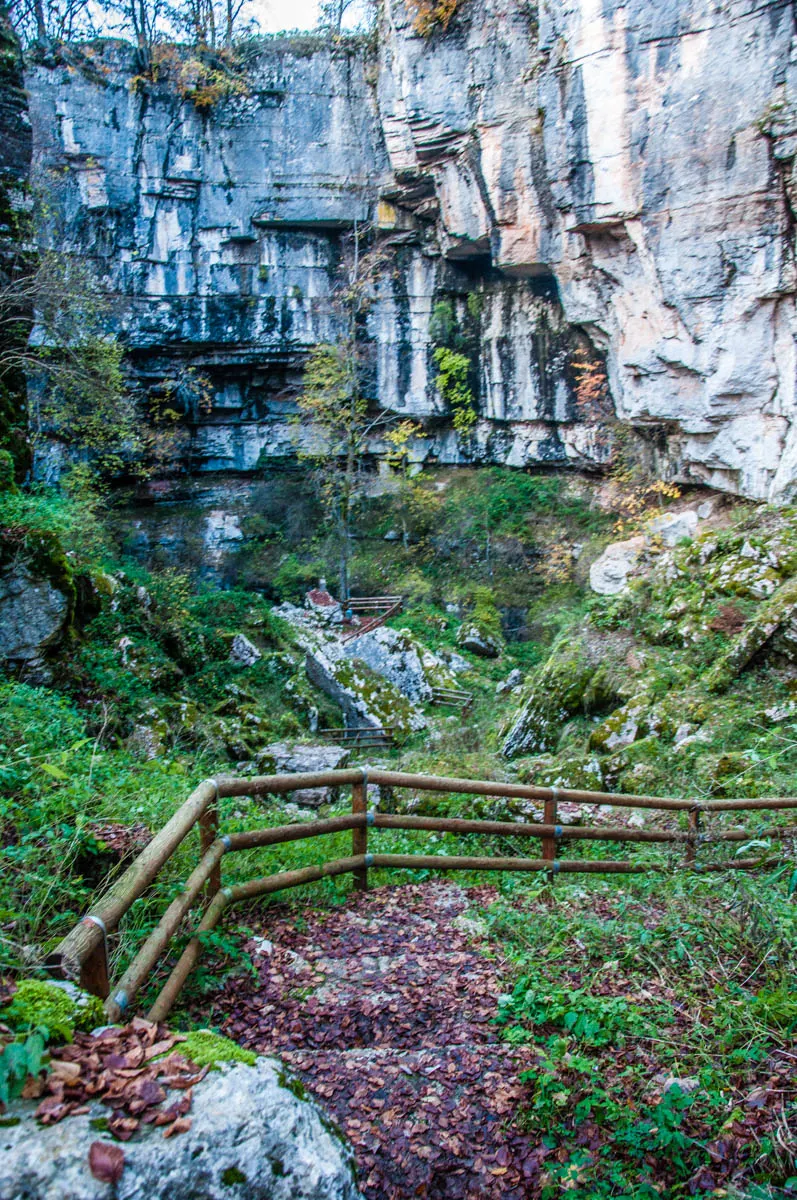
Covolo is a word in the Venetian language that is used to indicate karst sinkholes and caves.
In fact, the land of Veneto is rich in covoli. Hidden in the lushest corners of this part of Italy, many of them require a vigorous hike to reach and are linked to imaginative legends and myths.
None is as impressive as the Covolo di Camposilvano though which inspired Dante himself for the descriptions of Hell in his Divine Comedy.
Covolo di Camposilvano is in the heart of Lessinia – a stunningly beautiful group of hills near Verona and Lake Garda. This collapsed sinkhole is so huge that it has its own microclimate. Apparently, sometimes in the middle of summer, it snows inside!
You will find the covolo in the tiny village of Camposilvano in the Lessinia Hills. The village has one of the best-appointed geopaleontological museums that I have had a chance to visit. The museum has an excellent collection of ammonites and other high-quality fossils. There is a full skeleton of a cave bear, too). The museum was born out of the passion of a local man – Attilio Benetti – who dedicated his life to the study of fossils and became one of the world’s leading experts on ammonites.
A ticket to the museum also gives you the opportunity to visit the Covolo di Camposilvano. A path starting at the back of the museum leads you first up and then down almost all the way to the bottom of the enormous collapsed sinkhole. From there you can see the caves – opening like hungry mouths – at the base of the tall rugged stone walls that surround you on all sides.
It’s no wonder that Dante during his visits to this mysterious place got his inspiration for Hell. He described it as having a lake of ice on the bottom much like the thick layer of ice that could be observed in the caves on the bottom of Covolo di Camposilvano up until the middle of the 20th century.
I visited Covolo di Camposilvano at the end of a sunny November day after spending a lovely afternoon in the nearby Valley of the Sphinxes. Standing at the bottom of the cylindrical sinkhole while not really knowing how deep the caves around us went and what mysteries could be lurking in them, felt quite disquieting.
Slowly, slowly with the passage of the millennia, Nature creates the most powerful landscapes and then our human imagination runs truly wild just looking at them.
10. Church of San Simeon Piccolo, Venice
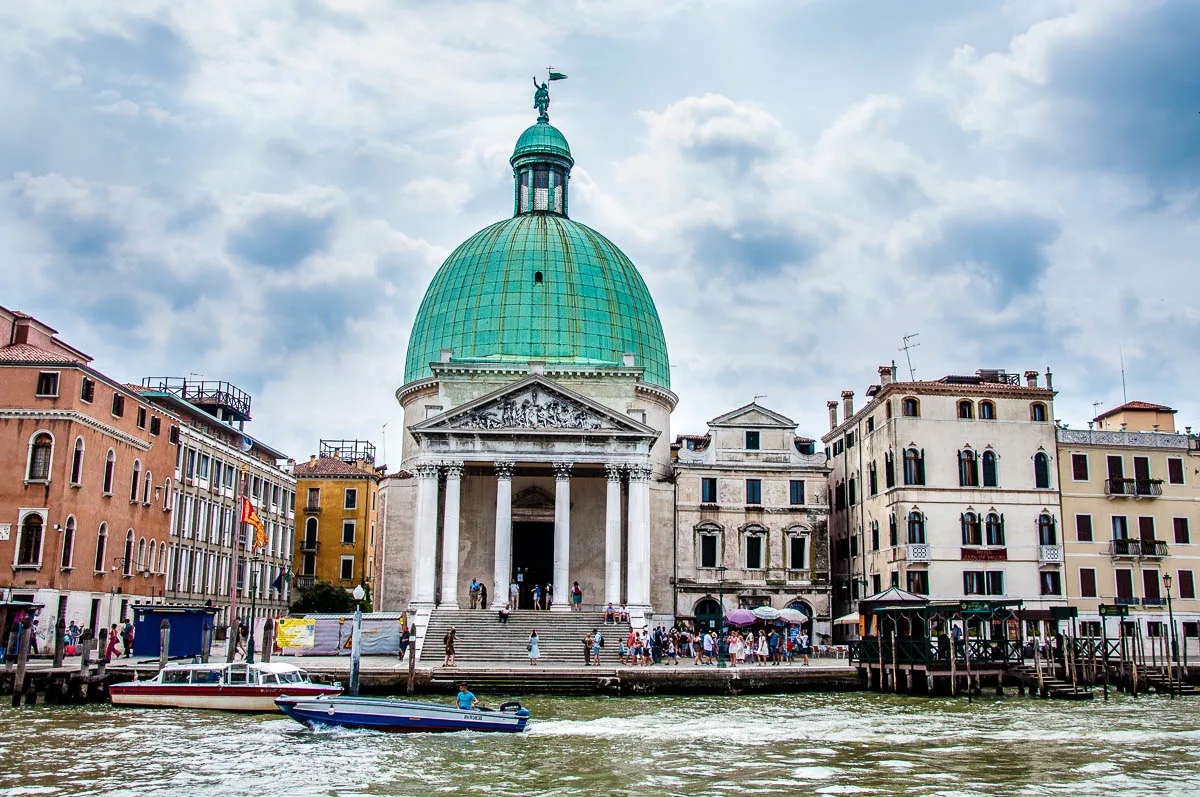
The Church of San Simeon Piccolo is the first splendid sight you see just as you have arrived in Venice and are walking out of the Venezia Santa Lucia train station.
The church’s huge dome is the first thing that grabs your eye. Yet, the truly interesting thing here though is the church’s funerary crypt. Dark and dank, you can visit it provided you pay the small entrance fee and have strong nerves. The guardian will hand you a lit candle and point you down the steps. Then, you are on your own.
The crypt is pitch black save for a single light bulb that produces the weakest, smallest circle of light. The candle in your hand throws flickering shadows over the surrounding walls revealing faded frescoes which depict scenes from the Last Judgement and the Old Testament.
Several corridors start from the central octagonal space in the middle of which stands an altar covered with a dark cloth. Along each corridor are the entrances to 21 chapels in total. They were used for centuries as final resting places for the local parishioners. Eight of them have never been studied and stand sealed and unexplored to this day.
I have to admit that the first time that I visited the funerary crypt of the Church of San Simeon Piccolo in Venice, I almost had an anxiety attack. I walked in, candle in hand, and suddenly the darkness inside felt scary and threatening. I tried to force myself to explore the corridors and the different chapels, as I really wanted to see the frescoes on the wall but I couldn’t make myself walk. I almost ran upstairs and outside.
The next time that I went to the crypt, I braved it together with my husband and hid behind his back for most of the time. It was still a highly mysterious place, dark and foreboding but I am glad I had a chance to see its frescoes, already disintegrating in the damp. You can see pictures of my visits to the crypt by clicking here and here.
Would you brave it yourself?
Do They Celebrate Halloween in Italy?

Let me finish this list with the ten mysterious places to visit in the Veneto with an answer to the often asked question:
Do they celebrate Halloween in Italy?
I will focus particularly on the Veneto as after living there for six years, I feel my first-hand observations are valid mostly for this northeastern corner of Italy.
The celebration of Halloween is gaining momentum in the Veneto. There is a well-established Italian phrase for ‘Trick or Treat!’ (click here to find out what it is). Plus, more and more kids dress up for Halloween each year and even engage in humble trick or treating attempts.
In Vicenza – the city in the Veneto where I lived – there were even large scale events for Halloween in 2019 with dancing, costumes, and sweets for the kids.
At the same time, the penetration of Halloween is strongly opposed to. Especially by families who feels that it threatens their Catholic faith. Last year, for example, a message was circulated on the WhatsApp group of school parents I belonged to asking us not to allow the ‘celebration of darkness’ into our hearts.
I am Bulgarian and Halloween is a new import for Bulgaria, too. I have never celebrated Halloween and I neither oppose it nor support it. I just curiously observe the tribulations around it and spend time thinking about them from a purely cultural and a bit historical point of view.
So, yes, it was interesting to see how divided the Italians were on the topic of Halloween. How some ladies were really worried about it becoming more widely accepted and how some school kids were saying that it was the holiday of the cattivi (the baddies) while other children couldn’t wait to wear the scary costume they had picked.
It all culminated with two Facebook posts by Veneto’s governor Luca Zaia made in 2017 and then in 2019. You can see them both here and here. In them, he told the story of the Veneto’s tradition of the lumere. These were carved pumpkins that had lit candles stuck inside and were then displayed on windowsills or along the ditches. The pumpkins were known as lumere or suche baruche.
They illuminated the way for the souls of departed loved ones and at the same time, disoriented the most spiteful dead.
Sometimes, the local boys – armed with carved pumpkins with lit candles inside – would hover on dark streets or near the cemeteries and scare the passers-by. Then, they will go from home to home asking for dried nuts and chestnuts.
Many people liked and commented on Mr. Zaia’s Facebook posts. Some of them wrote about other ancient rites of the Veneto linked to the period between the 31st October and 2nd November. It was interesting to read them and to understand how closely centuries-old traditions are connected around the world.
In addition, pumpkins are the real culinary star of the Veneto in autumn. There are so many local food festivals (called sagra) dedicated to them, so many recipes in which they play the leading role that it’s impossible to spend time in the Veneto in autumn and not eat pumpkin or a dish with pumpkin at least once.
One final note. The traditional for Italy celebrations for this period are:
- Ognissanti – All Saints’ Day which is marked on 1st November. It is a Catholic feast day and a national holiday. On this day are honoured all the Catholic saints and martyrs, especially those who don’t have their own day.
- I Morti – Day of the Dead which is marked on 2nd November. On this day, people in Italy traditionally visit the tombs of their departed loved ones and spend time commemorating them.
Is Halloween going to officially join the ranks of these two Italian celebrations? Is it going to do it as the commercialised Halloween or as the traditional Venetian lumere?
Only time will tell!
In Conclusion
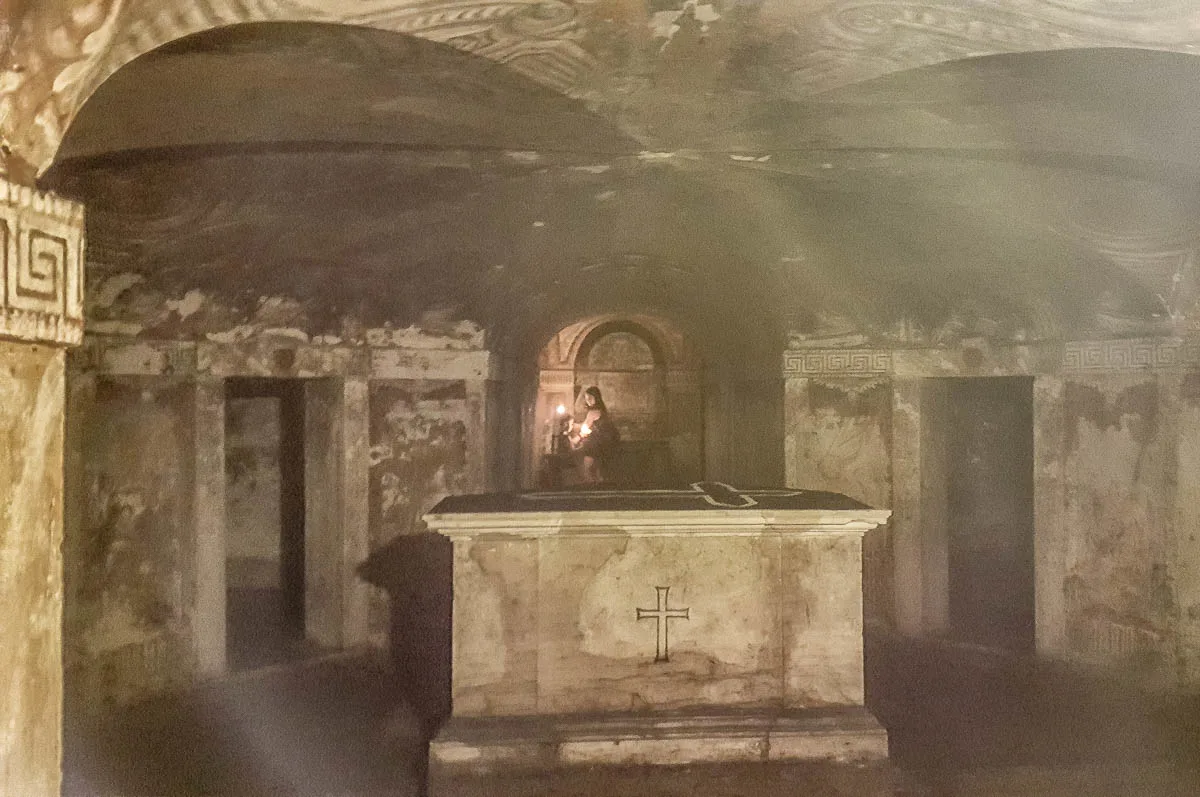
With Halloween around the corner, a good session of storytelling is never amiss.
So, in the above blog post, I am telling you the stories of the ten most mysterious for me places to creep yourself out at in the Northern Italian region of the Veneto.
From castles haunted by ghosts to mythical creatures with cloven feet inhabiting bodies of water, from a funerary crypt with frescoed chapels where local parishioners were buried for centuries to a tiny yet incredibly deep lake where strange screams and hissing sounds come from in the night, I have covered a wide variety of curious and unique sights for you to experience for yourself.
In addition, I have included some information about Halloween in Italy which I hope you found interesting to read.
Enjoy experiencing the mysteries of the Veneto!
Have a spooky Halloween!
More Helpful Links
- How to Say ‘Trick or Treat’ in Italian
- The Spookiest Place in Italy
- Haunted Venice – Legends, Mysteries, and Stories to Creep Yourself Out About the Most Romantic Place on Earth
- 10 Best Cities in Veneto, Italy to Visit and What to See in Each
- 30 Days of Adventures in the Veneto, Italy – #30daysofadventures
- Top 15 Places to Visit in the Veneto, Italy – The Ultimate Guide
- 15 Most Colourful Places in the Veneto, Italy to Delight Photographers and Curious Travellers
- 8 Most Beautiful Villages to Visit in the Veneto, Italy
- Italian Gardens – How to Visit Four of Italy’s Most Beautiful Parks in the Veneto
- Italian Piazzas – 20 Most Beautiful Squares in the Veneto, Northern Italy
- Best 12 Towns to Visit around Lago di Garda – Italy’s Largest Lake
- Lake Garda with Kids or The Best 11 Things to Do at Lake Garda for Families
- Day Trips from Verona – 16 Destinations in Italy to Fall in Love with (With Travel Times and Train Tips)
- Day Trips from Padua, Italy – Over 25 Unmissable Destinations in the Veneto, Lombardy and Emilia-Romagna
- Day Trips from Vicenza, Italy – Over 90 of the Best Destinations
- 11 of the Best Day Trips from Venice (With Lots of Photos, Travel Times and Italy Train Tips)
Thank you for reading! Please, leave me a comment, pin the image below or use the buttons right at the top and at the end of this blog post to share it on social media.
For more useful information like this, please, like my blog’s page on Facebook and subscribe to my strictly no-spam newsletter.

